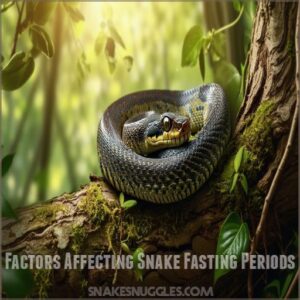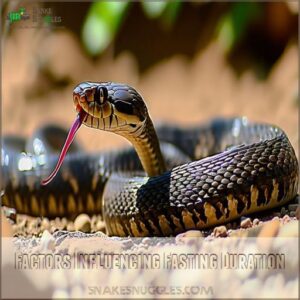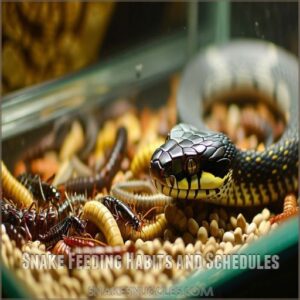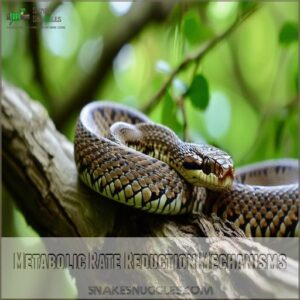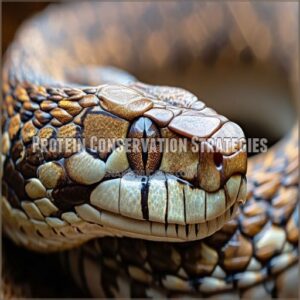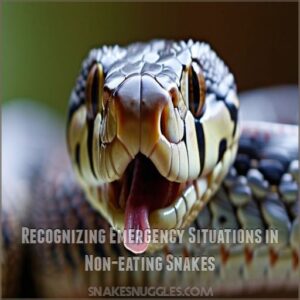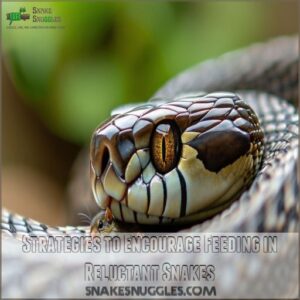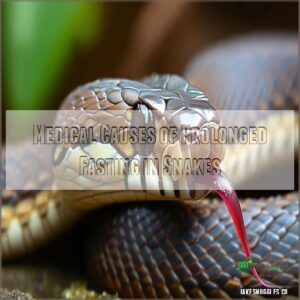This site is supported by our readers. We may earn a commission, at no cost to you, if you purchase through links.
 How long can a snake go without eating? Well, it mostly depends on the snake’s species, age, and environment.
How long can a snake go without eating? Well, it mostly depends on the snake’s species, age, and environment.
Some snakes can fast for weeks, with many lasting up to two months before they really feel the pinch of hunger.
Believe it or not, a handful of snakes can survive for several months or even years without a meal. They’re used to feast-or-famine cycles, especially in the wild.
Pet snakes, though, might give you the side-eye if you skip a meal.
Curious to know how they manage these epic fasts and keep their cool? Stick around for more intriguing insights!
Table Of Contents
- Key Takeaways
- Factors Affecting Snake Fasting Periods
- How Long Can a Snake Go Without Eating
- Snake Feeding Habits and Schedules
- Physiological Adaptations for Prolonged Fasting
- Signs of Hunger and Starvation in Snakes
- Health Risks Associated With Prolonged Snake Fasting
- Recognizing Emergency Situations in Non-eating Snakes
- Strategies to Encourage Feeding in Reluctant Snakes
- Medical Causes of Prolonged Fasting in Snakes
- Veterinary Intervention for Non-eating Snakes
- Frequently Asked Questions (FAQs)
- What happens if a snake doesn’t eat for a long time?
- How long can a snake go without food?
- Why do snakes not eat for extended periods?
- How frequently do snakes eat?
- How long does a snake refuse food?
- How long can a snake go without eating?
- How long can a snake survive without eating?
- What happens if a snake doesn’t eat?
- How often does a snake need to eat?
- How do you know when a snake is starving?
- Can a snake fast during brumation?
- What do snakes drink while fasting?
- Do different snake species fast differently?
- How does environment affect snake fasting?
- Can fasting snakes still maintain activity levels?
- Conclusion
Key Takeaways
- You’ll find that snakes can go weeks or even months without eating, depending on their species, age, and environmental conditions.
- Keep an eye on your pet snake’s health—prolonged fasting can lead to weakened immune systems and other serious health issues.
- If your snake refuses food beyond its normal fasting period, it might be a sign of stress, illness, or environmental changes; in such cases, visiting a vet is essential.
- Adjust prey size and type, modify the feeding environment, or address stressors if your snake hesitates to eat, ensuring they’re comfortable and healthy.
Factors Affecting Snake Fasting Periods
Several things affect how long a snake can go without food, just like how your own appetite might change depending on the season or if you’re feeling sick.
These factors include the snake’s species, age, whether it’s breeding, if it’s shedding its skin, and the time of year.
Snake Type and Size
The length of time a snake can go without eating is greatly influenced by its body length and venom type.
Bigger snakes, like pythons, have more fat reserves, which means they can fast for longer.
Meanwhile, smaller snakes need more frequent meals.
A snake’s diet and habitat, along with its temperament, also influence how long they can comfortably fast.
Snake Age
Just like people, snakes change as they age, affecting how long they go without a meal. Younger snakes grow quickly and need frequent meals, while older ones mightn’t eat as often. Here’s the scoop:
- Some snake species, such as green anacondas and reticulated pythons, can live over 30 years with proper care and a suitable environment, having an impact on their snake species lifespan comparison. Snake lifespan varies by species
- Growth rate slows over time
- Age-related health can impact appetite
- Maturity time influences feeding habits
Breeding Time
During breeding season, snakes often fast to focus on mating rituals.
It’s like a singular culinary distraction—finding a mate takes center stage.
With clutch size and incubation period pressing matters, they’re unconcerned with meals.
For example, the female snake may even stop feeding two weeks before breeding to reduce stress, as part of the snake breeding preparation.
The parental care afterward has all their attention.
So, don’t fret if your snake skips dinner; it’s all part of nature’s plan.
Shedding
While breeding might cause a snake to skip meals, the shedding process often impacts their appetite too.
As snakes prepare to shed their skin—a bit like changing an old sweater—they might refuse food.
This shedding frequency varies, depending on growth and health.
Shedding triggers can include growth spurts or environmental changes, making it a fascinating yet predictable cycle.
Time of Year
When it’s winter, snakes often experience brumation, akin to hibernation, reducing activity and ignoring meals altogether.
Spring emerges, their appetite returns in sync with increasing seasonal food availability.
Much like us raiding the fridge after a snooze, snakes rely on stored energy during colder months, marking time of year as a pivotal fasting factor.
How Long Can a Snake Go Without Eating
You might wonder how long your pet snake can skip meals without turning into a drama queen.
Whether you’ve got a ball python or a boa constrictor, these reptiles are surprisingly resourceful, typically lasting weeks to months, depending on their species and environment.
Average Fasting Periods for Pet Snakes
So, you’re curious about how long your pet snake can go without a meal?
It varies wildly depending on the snake species, its age, and even the time of year.
For example, a young corn snake needs food every week, but an adult can easily skip a meal or two.
Ball pythons are a bit different; adults eat every 10-14 days, while youngsters need to eat more often.
Remember, brumation (snake hibernation) means they’ll fast for a while.
Always check with a vet if your snake refuses food for weeks.
Fasting Periods for Wild Snakes
In the wild, survival strategies are key for snakes, who often face long fasting periods due to fluctuating prey availability.
Imagine this: a snake coiled under a rock, practicing patience that’s almost like a superpower.
Depending on species and environment, these reptiles can hibernate and adapt, going weeks or even months without a meal, showcasing nature’s remarkable resilience and natural selection.
Factors Influencing Fasting Duration
Wild snakes may go without a meal longer than you might think. Several factors play into this impressive survival skill:
- Ambient Temperature: Cold weather slows their metabolism.
- Prey Availability: Less food means longer fasting.
- Snakes have evolved to survive prolonged fasting, with some species like Ball Pythons Snake Fasting Snake Fasting Periods lasting up to 6-8 months without harm.
- Environmental Stress: Disturbances can disrupt feeding.
- Species Metabolism: Some snakes naturally need less food.
- Snake Health: A healthy snake withstands fasting better than a sick one.
Snake Feeding Habits and Schedules
You’re not alone in wondering how snakes keep track of their meals, especially with their varied lifestyle.
In the wild, they depend on the unpredictable availability of prey, while pet snakes have structured feeding schedules that mimic their natural patterns, helping them stay happy and healthy. Understanding your snake’s individual feeding habits can help you create a schedule that meets their needs, ensuring they get the right amount of food. while pet snakes have structured feeding schedules that mimic their natural patterns, helping them stay happy and healthy.
Natural Prey Availability in The Wild
Imagine a snake hunting in its wild playground, where the menu depends on seasonal variations and prey abundance.
Habitat changes and predator competition spice things up, pushing snakes to adapt clever hunting strategies.
Whether hiding in shadows or waiting patiently, these reptiles play survival chess in nature’s game board, ensuring they stay fed and ready for their next move.
Controlled Feeding Schedules for Pet Snakes
Think of a snake’s meal schedule like clockwork.
Pet snakes, depending on their species and age, need regular feedings to stay healthy.
Some munch once a week, while others stretch it to two.
During brumation—think of it as their winter hibernation—don’t be surprised if their eating slows down.
Keep the prey type varied to match their natural diet preferences.
Impact of Environmental Factors on Feeding
Some species, like certain pythons, can survive up to 2 years without food, but a snake’s eating habits are like a fine-tuned machine that depends on the environment. If the temperature or humidity isn’t right, dinner might be a no-show.
- Temperature: Too hot or cold can spoil appetite.
- Humidity: Low levels can dehydrate snakes, reducing hunger.
- Prey Availability: Scarcity makes snakes adapt.
- Seasonality: Changes in seasons influence hunger.
- Habitat Change: New surroundings might stress them out.
Physiological Adaptations for Prolonged Fasting
Snakes aren’t exactly known for their frequent trips to the buffet, are they?
To survive long stretches without food, they’ve evolved some pretty amazing tricks.
They slow their metabolism and store energy efficiently.
Metabolic Rate Reduction Mechanisms
Snakes have a knack for survival, often adapting their metabolism to conserve energy, which can also be supported by specialized products focused on snake energy conservation, such as reptile energy boosters.
They perform a digestive slowdown and shift to cellular efficiency, allowing their systems to run on low energy.
Imagine it like putting your phone on battery saver—everything slows down.
With reduced activity, snakes stretch their resources, ensuring they stay healthy even when food is scarce.
Energy Storage in Fat Reserves
As a snake’s metabolism shifts down a gear to save energy, it calls on its fat reserves like a squirrel taps into its stash for winter.
These reserves act like a snake’s personal battery, fueling it through fasting periods.
Not quite a hibernation, this energy conservation keeps snakes steady, maintaining their weight as they breeze through hungry days.
Organ Shrinkage During Starvation
Ever wonder how snakes manage during starvation? They shrink their organs to save energy—talk about extreme survival strategies! This metabolic change is a clever way to conserve energy, keeping them on life’s tightrope. When hunger strikes long-term, snakes’ organs reduce in size, slowing down functions.
- Organ function adapts through resizing
- Helps in energy conservation
- Crucial for survival strategies
Protein Conservation Strategies
Think of snakes as the ultimate survivalists, managing amino acid utilization like a squirrel stashes nuts for winter.
They slow metabolic rates and minimize muscle breakdown, conserving energy stored in fat reserves.
This remarkable strategy helps them survive starvation as organs shrink gracefully.
It’s a clever balancing act, showcasing their resilience in the wild world of hunger games!
Signs of Hunger and Starvation in Snakes
When your pet snake starts behaving like it’s training for a reptile marathon, complete with increased activity and rapid tongue flicking, it’s probably hungry.
If left unfed, more serious signs like visible ribs and sunken eyes might appear, resembling a scaly supermodel’s worst nightmare.
Increased Activity and Tongue Flicking
You might notice your snake acting like it’s plotting the next big escape plan.
Increased activity and frequent tongue flicking are sure signs it’s searching for food.
These hunger cues usually hint that your snake’s finely tuned hunting instincts are kicking in.
They’re not just practicing yoga—they’re on the lookout for prey, considering environmental factors for any hint of a meal.
Weight Loss and Body Condition Changes
Besides increased activity, noticeable weight loss is a key sign your snake’s hungry.
You can monitor this using body condition scoring.
A significant drop in weight, coupled with a loss of muscle mass, indicates depleted fat reserves and a slowing metabolic rate.
This isn’t ideal, so keep a close eye on your snake’s weight.
Remember, a healthy snake is a happy snake!
Behavioral Changes and Aggression
When hunger strikes, snakes might act a bit crankier than your old neighbor.
You’ll notice changes like:
- Increased defensiveness: They’re more likely to lash out.
- Restlessness: Like pacing back and forth when they’re nervous.
- Uncharacteristic aggression: Even calm ones might suddenly strike.
These behaviors can reflect stress, hibernation, or illness, subtly hinting at their need for a bite to eat.
Visible Skeletal Structure and Sunken Eyes
Seeing a snake’s skeletal structure or sunken eyes can be as jarring as spotting a tumbleweed in a desert.
These signs of dehydration and starvation spell trouble, pointing to serious health concerns.
Rapid weight loss isn’t a cosmetic issue—consider a vet visit pronto.
Prioritizing your snake’s health helps keep those bones and eyes where they belong: out of sight.
Health Risks Associated With Prolonged Snake Fasting
When your snake skips meals for too long, you’re not just facing a grumpy reptile but a range of health risks, such as a weakened immune system and muscle wasting.
These issues can snowball, leading to serious problems like organ failure and even reproductive troubles, making timely meal management essential for your pet’s well-being.
Weakened Immune System
Notice your snake’s increased activity or sunken eyes? These could be whispering signs of a weakened immune system.
A snake not eating faces health risks, becoming vulnerable to diseases.
Consider these steps to support your snake’s health: Boost environmental conditions, ensuring proper temperature.
Offer a varied diet to support snake immunity.
Regular vet visits to prevent reptile care issues.
Organ Damage and Failure
Skipping meals for too long? That can lead to organ damage, threatening your snake’s health.
Organs may struggle with function, recovery time stretches out longer, and long-term effects can arise.
A vet’s intervention can be your snake’s lifeline.
Keep an eye on these issues:
| Organ | Function Affected | Recovery Time |
|---|---|---|
| Liver | Detoxification | Prolonged |
| Kidneys | Waste Elimination | Extended |
| Heart | Circulation | Lengthy |
Muscle Wasting and Mobility Issues
Imagine a snake struggling like a couch potato whose remote batteries died—it’s not pretty.
Extended fasting can lead to muscle atrophy, impacting their mobility and hunting prowess.
Similar risks of muscle breakdown and loss are seen in humans who drastically cut calories, highlighting the importance of balanced nutrition.
Keep an eye out for:
- Muscle atrophy: Weakness that slows them down.
- Mobility loss: Struggles slithering gracefully.
- Impact on hunting: Reduced success catching prey.
Consult a vet for potential treatment.
Reproductive Problems and Infertility
Prolonged fasting has a major impact on snake reproduction.
For female snakes, inadequate nutrition during breeding season can lead to poor egg production or even infertility.
A well-stocked Snake Health Products can help prevent these issues.
Think of it like this: a mom needs energy to make babies!
Mating problems might also arise from a weakened state.
So, keeping your snake well-fed is very important for successful snake reproduction.
Recognizing Emergency Situations in Non-eating Snakes
When your snake skips a meal or two, it might just be a regular fasting period, but if it starts turning up its nose at food regularly, that’s a red flag.
Understanding when a snake’s hunger strike is a cause for concern can save you from a slithery surprise down the road.
Normal Fasting Periods Vs. Problematic Refusal
When your snake skips a meal or two, don’t panic—some fasting is normal.
Yet, if the fasting stretches beyond a couple of weeks, it could signal an underlying issue.
Keep an eye on any changes in behavior or weight.
If you’re concerned, a quick call to a veterinarian can shed light on whether this refusal is typical or needs attention.
Juvenile Snake Feeding Requirements
For juvenile snakes, feeding frequency is very important. They’re growing fast, and their nutritional needs are high. To make sure they’re thriving, keep an eye on these three points:
- Prey Size: Offer appropriately sized meals.
- Supplements: Consider adding vitamins if necessary.
- Growth Rate: Adjust the diet as the snake develops.
This trio keeps your scaly buddy healthy and happy!
Adult Snake Feeding Frequency
Moving from juvenile needs to adult snake feeding frequency, remember, the larger snakes become, the less often they munch.
Think of it as a lazy Sunday brunch—every 10 to 14 days for most species.
Here’s a quick guide:
| Snake Species | Feeding Schedule | Prey Size |
|---|---|---|
| Ball Python | 10-14 days | Medium |
| Corn Snake | 7-10 days | Small |
| Boa Constrictor | 14 days | Large |
Signs of Severe Malnutrition
Noticing changes in your snake’s skin and bones can be alarming.
A skinny body, lethargic behavior, sunk eyes, and protruding ribs signal severe malnutrition.
Your scaly friend might seem like it’s just sleepy, but it’s running on empty.
Focus on providing proper nutrition and habitat, because energy is essential, and ignoring hunger signs may spell trouble for its health.
Strategies to Encourage Feeding in Reluctant Snakes
When your snake decides to starve itself like a moody teenager, it’s time to try some clever feeding strategies.
By adjusting prey size, tweaking the environment, and managing stress, you can help entice even the pickiest eaters.
Adjusting Prey Size and Type
Is your snake refusing dinner? Sometimes, it’s not a big deal, but sometimes it is. Let’s talk about prey size and type.
A picky eater? Try offering different prey. Many snakes thrive with Varied Diet Options, which can prevent nutritional deficiencies and keep them mentally stimulated.
Prey size should match your snake’s age; age-based feeding is key.
Consider prey variety—a change of pace might do the trick. Experiment with prey choice to find what works best.
To maintain a happy and healthy snake, it’s essential to consider their unique food preferences, such as some species favoring frozen-thawed rodents. Remember, proper prey frequency is essential for a happy and healthy snake.
Modifying Feeding Environment and Techniques
To encourage your snake to eat, the feeding environment might need a tweak. Imagine the excitement of changing things up!
- Enclosure changes like altering lighting or warmth can stir a snake’s appetite.
- Prey presentation in various styles can intrigue them—try a little dance with tweezers.
- Offer food variety to cater to their wild palates—be the snake chef!
Addressing Potential Stressors
Think of stressors like hidden villains in your snake’s habitat.
Handling stress or lack of prey availability can throw them off their game.
Make sure your snake’s water quality is excellent and reduce excessive social interaction.
A peaceful enclosure promotes calm vibes. Imagine a spa day for your scaly friend—everything in its place, and peace reigns.
Proper Temperature and Humidity Maintenance
Got a fussy snake on your hands? Adjusting the enclosure’s temperature and humidity can work wonders. Snakes feel cozier when their environment mimics the wild. You can find the perfect basking lamp for your snake’s needs at a pet supply store like those found on basking lamp products.
- Temperature control: Use a basking lamp and a thermometer to create ideal conditions.
- Humidity levels: Keep it just right with a hygrometer.
- Ventilation: Make sure there’s airflow to prevent health issues.
Medical Causes of Prolonged Fasting in Snakes
If your snake isn’t eating, it might be more than picky eating habits; illnesses like respiratory infections, mouth rot, and parasitic infestations can cause prolonged fasting.
Understanding these health issues and recognizing signs such as neurological concerns is essential to keeping your scaly buddy healthy and happy.
Respiratory Infections and Mouth Rot
When your snake’s refusing food, it might be battling respiratory infections or mouth rot—two heavyweights in the health arena.
These issues can disrupt their appetite, much like a nasty cold or cavity woes for us.
Regularly checking for signs of hibernation versus illness identifying snake hibernation is crucial in maintaining snake health. Keeping snake health in check with regular oral hygiene is key.
If you spot symptoms, hustle to your vet for infection prevention and effective treatment options.
Parasitic Infestations
Snakes, much like us dealing with the sniffles, can struggle when pesky parasites invade.
You might notice your slithery pal skipping meals.
Common parasites? Think mites or worms. They wreak havoc, causing:
- Reduced appetite
- Weight loss
- Behavior changes
Check those scales for signs!
Identifying the intruders, treating promptly, and preventing future infestations keeps your snake healthier.
Digestive System Disorders
Besides parasites, if a snake eats something too big, it may experience risks of oversized prey. Digestive issues can also cause your snake to skip meals.
Problems within their digestive tract, like blockages or inflammation, can make eating painful.
These gastrointestinal problems need vet attention.
Here’s a quick guide:
| Issue | Symptom | Treatment | Prognosis |
|---|---|---|---|
| Impaction | Swollen belly, lethargy | Surgery, fluids | Varies, can be serious |
| Inflammation | Vomiting, lack of appetite | Medication, supportive care | Generally good with treatment |
| Infection | Diarrhea, weakness | Antibiotics | Depends on severity |
| Congenital defects | Failure to thrive | Supportive care, surgery (if possible) | Varies greatly |
Early detection improves the odds for your scaly friend.
Don’t delay seeking help if you suspect digestive trouble.
Gut health is key!
Neurological Issues Affecting Feeding Behavior
Imagine grappling with neurological hiccups like brain tumors or nerve damage.
These can spoil a snake’s dinner plans faster than you can say "metabolic disorder."
Look out for:
- Encephalitis: Inflammation that muddles brain function.
- Seizures: Unpredictable and alarming episodes.
- Nerve issues: Disrupt the journey from appetite to action.
- Metabolic chaos: Throws off the body’s balance.
Follow these cues to help your slithery friend enjoy its meals again.
Veterinary Intervention for Non-eating Snakes
If your snake refuses to eat for longer than its typical fasting period, it’s time to think about a vet visit to rule out health issues.
Diagnostic procedures can include physical exams and tests designed to pinpoint the underlying problem, ensuring your slithery buddy gets back to munching happily.
When to Seek Professional Help
Spotting a snake’s unusual behavior, like refusing food or sudden weight loss, might feel like reading a mystery novel where the ending keeps you guessing.
The culprit could be something as simple as an improper enclosure setup or inadequate husbandry practices, stressing your snake and putting it off its food.
If prolonged fasting is your snake’s style, it’s time to seek a vet’s wisdom.
Just like you’d call a car mechanic when your ride sputters, a specialist can reveal what’s up under the scales, ensuring your slithering friend stays in excellent health.
Diagnostic Procedures for Fasting Snakes
If you’re at your wit’s end with a non-eating snake, getting some diagnostic procedures could shine a light on hidden issues. Here’s what might happen at the vet:
- Physical Exam – Your vet will check the snake’s overall health, spotting any external issues.
- Blood Tests and Fecal Analysis – These uncover infections or parasites.
- Ultrasound and X-ray – These provide a peek inside, revealing potential organ or digestive problems.
Frequently Asked Questions (FAQs)
What happens if a snake doesn’t eat for a long time?
Your scaly friend’s a bit peckish? Don’t worry, snakes can go weeks, even months, without a meal, depending on the species and age.
But prolonged fasting can weaken them, so check with a vet if it’s been a while.
How long can a snake go without food?
A snake can typically last weeks to a few months without food, depending on its species, age, and environment.
Pet snakes need regular meals, but some wild snakes endure up to two years without eating.
Why do snakes not eat for extended periods?
Snakes often stop eating due to brumation, stress, illness, or environmental changes.
They’ve evolved to survive on low energy, so skipping meals isn’t unusual.
Check with a vet if the fast seems prolonged.
How frequently do snakes eat?
Picture a suave snake slithering through its days: young ones munch twice a week, while older snakes savor their meals every 7 to 14 days.
Feeding varies with species and activity, quite the unpredictable dining schedule!
How long does a snake refuse food?
A snake might refuse food for a few weeks, up to months if it’s stressed or during brumation.
Consult a vet if refusal extends to check its health, as hunger strikes vary with species, age, and environment.
How long can a snake go without eating?
Imagine going on a very long diet; certain snakes can do just that, surviving without food for weeks to even two years, depending on the species and conditions.
It’s nature’s way to guarantee their survival.
How long can a snake survive without eating?
You’re wondering how long they can last without a meal.
Depending on the species, a snake can go weeks to even two years without eating.
Their cold-blooded nature lets them conserve energy remarkably well.
What happens if a snake doesn’t eat?
If your snake’s skipping meals, don’t panic!
It might be brumating (winter sleep), or something’s amiss.
A vet check is always a good idea if it lasts longer than a few weeks.
They’ll help you figure out what’s up.
How often does a snake need to eat?
Snakes eat on different schedules: corn snakes every 7-10 days, adult ball pythons every 10-14 days, while juveniles need food twice weekly.
Feeding depends on species, age, and whether they’re in brumation.
How do you know when a snake is starving?
Imagine this: your snake won’t eat and seems lethargic, with loose skin and weight loss.
It’s like it’s wearing a saggy jacket. These are signs.
Act promptly, consult your vet, and make sure your pet’s diet is suitable.
Can a snake fast during brumation?
Yes, during brumation, your snake likely fasts as its metabolism slows down.
It’s like winter hibernation for reptiles, reducing activity and food intake.
Make sure the snake has access to fresh water during this period.
What do snakes drink while fasting?
Like wandering nomads sipping morning dew, snakes drink droplets from rainwater or mist on their scales while fasting.
This water intake supports them during food-free periods, ensuring hydration even when meals are scarce.
Do different snake species fast differently?
Different snake species fast differently due to their varied metabolism and habitat needs.
Some can go months without food, while others might only manage weeks.
Fasting ability depends on species, age, and environmental conditions.
How does environment affect snake fasting?
Snakes fast differently based on their environment.
Warmer climates speed up metabolism, so they may need food sooner.
Cooler conditions slow metabolism, allowing longer fasts.
Accessible food and water sources also influence fasting duration.
Can fasting snakes still maintain activity levels?
Don’t worry, a fasting snake’s activity depends on the species and how long it’s gone without food.
Generally, they’ll remain somewhat active, but their energy levels will decrease over time.
Think of it like a long nap!
Conclusion
Starving snakes, surprisingly, showcase survival skills by slowing metabolism and relying on stored energy.
Wild and pet snakes differ in how long they can go without eating. For most, hunger doesn’t hit hard until weeks or even months pass.
However, ensuring you recognize behavioral changes and maintain environmental conditions is key. Take swift action if your scaly friend skips more meals than usual.
So, how long can a snake go without eating? It truly varies—understanding your snake’s needs really matters.

